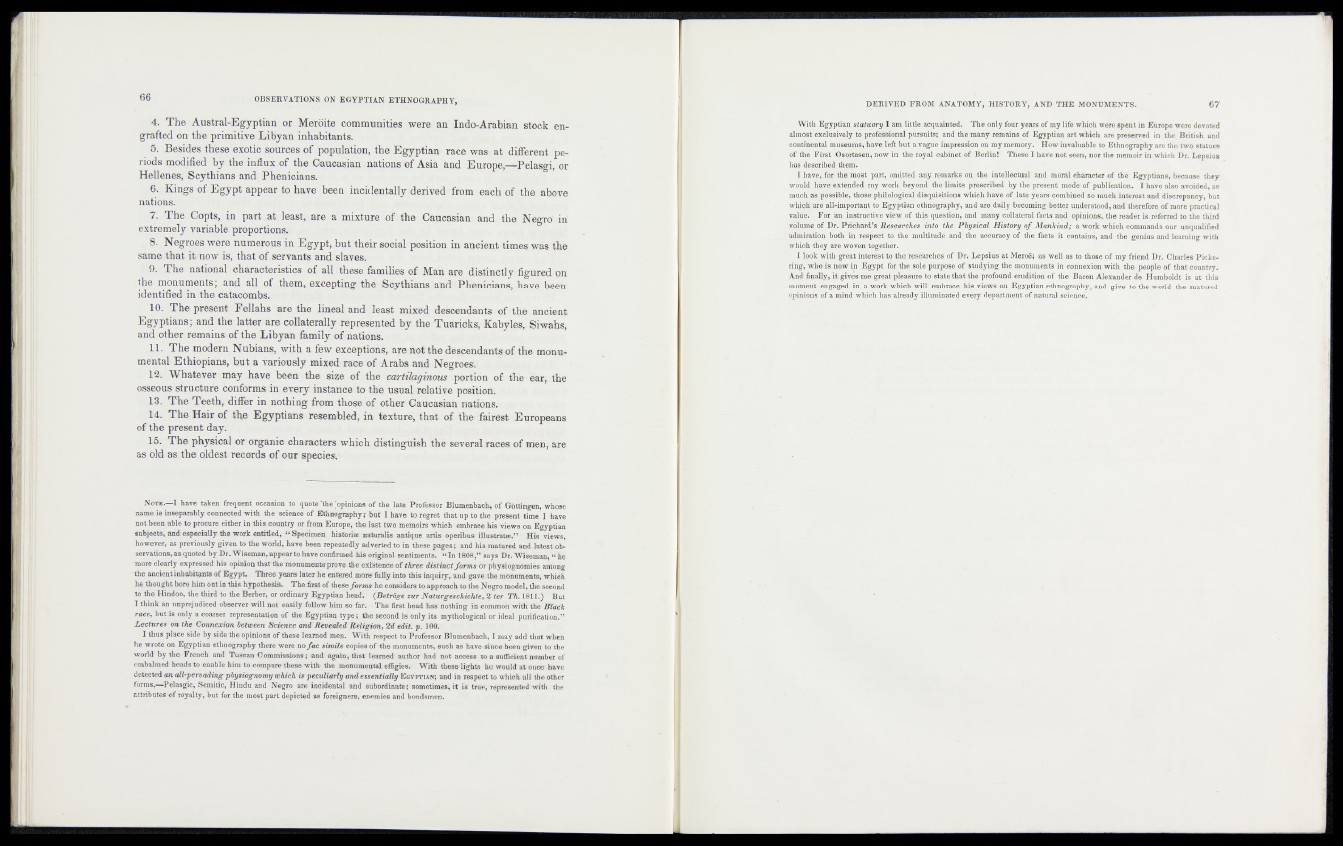
4. The Austral-Egyptian or Meröite communities were an Indo-Arabian stock en-»
grafted on the primitive Libyan inhabitants.
5. Besides these exotic sources of population, the Egyptian race was at different pe-
riods modified by the influx of the Caucasian nations of Asia and Europe;—Pelasgi, or
Hellenes, Scythians and Phenicians.
6. Kings of Egypt appear to hate been incidentally derived from each of the above
nations.
7. The Copts, in part at least, are a mixture of the Caucasian and th e Negro in
extremely variable proportions.
8. Negroes were numerous iff Egypt, but theirsocial position in ancient times was the
same that it-now is, that Of servants and slaves.
'9- The national characteristics of all these families of Man are distinctly figured on
the monuments; and all of them, excepting the Scythians and Phenicians, have been
identified in the catacombs.
10. The present Fellahs are the lineal and least mixed descendants of the ancient
Egyptians; and the latter are collaterally represented by the Tuaricks, Kabyles, Siwabs,
and other remains of the Libyan family of nations.
i n i 1- ^ e modern Nubians, with a few exceptions, are not the descendants of the monumental
Ethiopians, but a variously mixed race of Arabs and Negroes.
IS. Whatever may have been the size of the cartilaginous portion of iffie ear, the
osseous structure conforms in every instance to the usual relative position.
13. The Teeth, differ in nothing from those of other Caucasian nations^ ,
14. The. Hair of the Egyptians resembled, in texture^ that of the fairest Europeans
of the present day.
15. The physical or o nanie characters which distinguish the several races of uien, are
as oM as the oldest records of our species.
Nora,—I have taken freqnent occasion to quote the [opinions of the late Professor Blumenbach, of Göttingen, whose
name is inseparably connected with the science of Ethnography;- hot I have to regret that up to the present time I have
not been able to procure either in this öormtry or from Europe, the.last two memoirs which embrace his views on Egyptian
subjects, and: especially the work entitled, “ Specimen bistort« natural is antique artis operibus iilostrauev” His views,
however, as previously given to the world, have been repeatedly adverted to in these pages; and his matnred and latest observations,
asquoted by Dr. Wiseman,appeartq have confirmed his original sentiments! “ In 1808,’’ s a y s l^ ^ fq ^ a h ^ 'h fe
more clearly expressed his opmion thafthe monuments prove tier existence of three d&ftecf/oms-drphySiogn'dnties among-
“the ancient inhabitants of Egypt. Three years later he entered more fuRy into this inquiry, mid- gave the monuments, which
he thought boro him oatin this hypothesis.. The.first of these farm» he considers to-approach-to the-Negro model, the seoond
to the Hindoo, the third to the Berber, or ordinary Egyptian head; (Beträge zur Naturgeschichte, 21 ter T L
I think an unprejudiced observer will not easily follow him so far. The first head has nothing' iti-efflinlBotf wfth tbs Stack
race, but is only a coarser representation of the Egyptian type; tiie second is only its mythological or ideal purification.”
Lectures on the Connexion between Science and Revealed Religion, 2d edit. p. 100.
I thus place side by side the opinions of these learned men. With respect to Professor Blumenbach, I may add that when
he wrote on Egyptian ethnography there were no fac simile eopieg-of the monuments, such as have Since: been'given' to'the
world by the-French and Ttasean Commissions;'and again, that learned- anther had not access to a:sufficient number of
embalmed’ heads to enable1 him- to compare-these with the monumental- effigies. Wish’ these lights he would at once have
detected an all-pervading physiognomy which is peculiarly and essentially’ Egyptian; and' in respect to Which’ all) tbeother
forms,—Pelasgic, Semitic, Hindu and Negro are incidental and subordinate; sometimes; i f is true, represented with the
attributes -of royalty, hot for the inost part depicted as foreigners,enemies and bondsmen.
. With Egyptian statuary I am little acquainted. The only four years of my life which were spent in Europe were devoted
almost exclusively to professional pursuits; and the many remains of Egyptian art which are preserved in the British and
continental museums, have left but a vague impression on my memory. How invaluable to Ethnography are the two statues
qftthe First Osortasen, now. iff tide; royal cabinet of Berlin! These I have not seen, nor the memoir in which Dr. Lepsins
has described; t^em.
. I have, for the most part, Omitm^any remarks on the intellectual and moral character of the Egyptians, because they
would have extended my work beyond: the;limits prescribed by the present mode of publication. I have also avoided, as
'•MjS Ip o ssih le, thoselpffilblfigifca’lldisquisiiions whicK have, of late years-combined1^ much interest and discrepancy, bnt
whi(®are all-important to Egyptian ethnography, and aretdaily becoming better understood, and therefore of more practical
value; For an instructive view of this question, and- manyo collateral facts and opinions, the reader is referred to the third
ymume off Dr: Prichard’s Researches into the? Physical History o f Mankind; a work which commands our unqualified
admiration both in respect to Tliq?mu!"iiudi mtl the accuracy* of the facts it contains, and the genius and learning with
which they are woven- together. /
I look with great interest to* the researches of Dt. Lepsius at Meroe; as! well as to those of my friend Dr. Charles Pickering,
who is now in Egypt fofdljijS'lt purjust of stiuh'im tiie'nid iijk ntA m Affine woir with the people of that country.
And’ finally!, it gives me great pleasure to state that the profound erudition! of the Baron Alexander de HumjtoMt is at this
moment engaged III- a work whicli-AyiLll-.embrace his vie\ys|dn Egyptian ethnography, and give to the world the matured
opinions, of a mind’-v hu-li 1ms already illuminated every degaffmelrt'c® natural science.